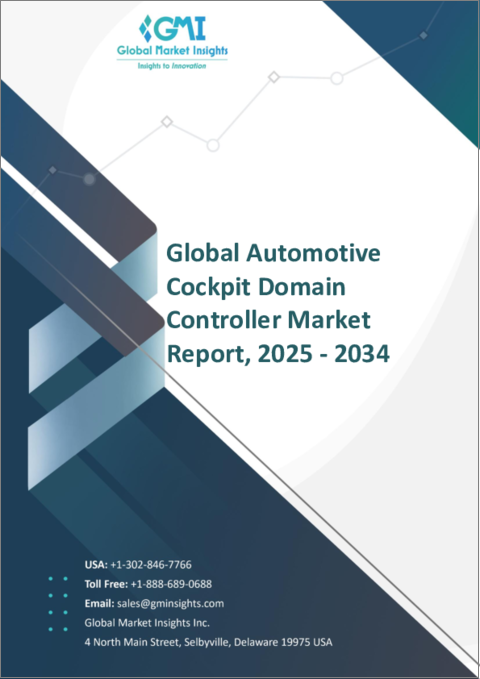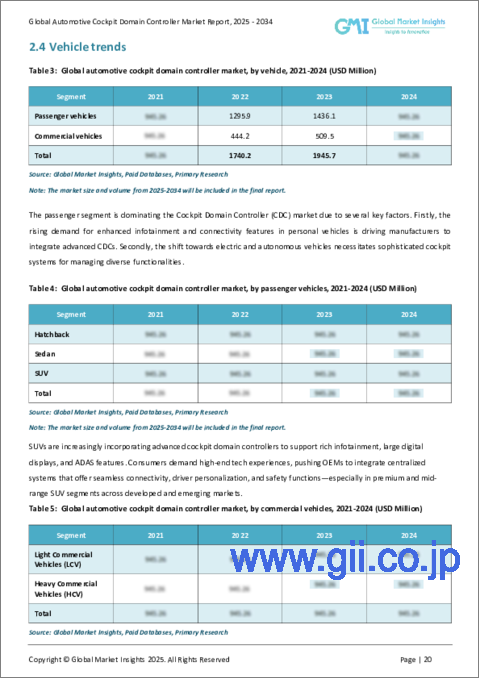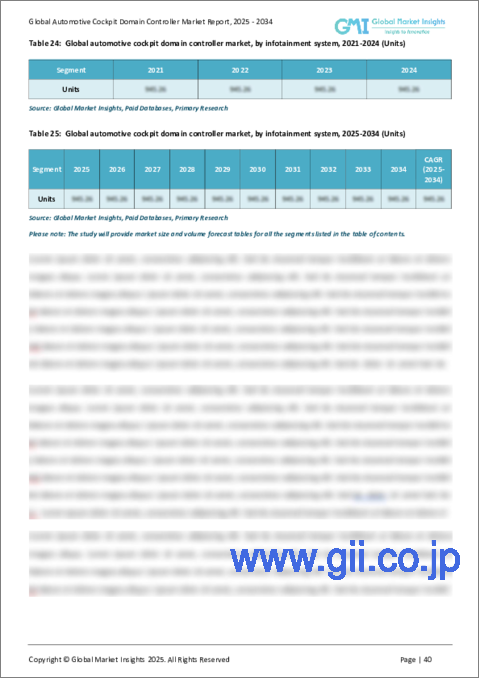|
|
市場調査レポート
商品コード
1620480
自動車用コックピットドメインコントローラー市場の成長機会、成長促進要因、産業動向分析、2024~2032年予測Automotive Cockpit Domain Controller Market Opportunity, Growth Drivers, Industry Trend Analysis, and Forecast 2024 - 2032 |
||||||
カスタマイズ可能
|
|||||||
| 自動車用コックピットドメインコントローラー市場の成長機会、成長促進要因、産業動向分析、2024~2032年予測 |
|
出版日: 2024年10月30日
発行: Global Market Insights Inc.
ページ情報: 英文 170 Pages
納期: 2~3営業日
|
- 全表示
- 概要
- 目次
自動車用コックピットドメインコントローラの世界市場は、2023年に19億米ドルとなり、2024~2032年にかけてCAGR 22.03%で拡大すると予測されています。
この成長は、自動車が高度に接続されたエコシステムに変化するにつれて、統一された没入感のある車内体験を求める消費者需要が増加していることが主要要因です。今日のドライバーは、合理化されたインターフェースの中で、インフォテインメント、ナビゲーション、運転支援の統合ソリューションを求めています。自動車メーカーは、複数の制御ユニットを単一のドメイン・コントローラに統合することで、処理能力を最適化し、配線の複雑さを最小限に抑え、性能と設計効率の両方をサポートすることで対応しています。電気自動車(EV)へのシフトも市場を後押ししています。これらの自動車は、コンパクトでエネルギー効率の高い設計で、バッテリ寿命、ナビゲーション、インフォテインメントなどの機能を管理する先進的電子システムに依存しているからです。
コックピットドメインコントローラは、これらのコンポーネントのシームレスな統合を可能にし、従来の制御ユニットのスペースとエネルギー要件を削減することで、EVメーカーの目標に合致しています。この相乗効果は、持続可能性と効率的な車両アーキテクチャに対するEVセクターのコミットメントと一致し、コックピットドメインコントローラの需要を加速しています。市場セグメンテーションは車種別に行われ、乗用車と商用車の両方が含まれます。乗用車は2023年に市場シェアの75%以上を占め、2032年には70億米ドルを超えると予測されています。消費者は音声認識やタッチ式インターフェースなどの機能を搭載した車両を好むようになっており、個人向け車両における先進的インフォテインメント機能や接続性機能に対する関心の高まりがこの動向を後押ししています。
電気自動車や自律走行車の台頭は、幅広い機能を管理し、先進的ユーザー体験を提供できる洗練されたコックピットシステムの必要性をさらに高めています。推進力に関しては、市場は内燃機関車(ICE)と電気自動車に分かれます。2023年には内燃機関車が市場の80%以上を占めるが、これは主に、確立されたインフラ、広範な給油ネットワーク、この技術に対する消費者の馴染みの広さによるものです。しかし、電気自動車は、バッテリー技術の進歩により、車両の航続距離を伸ばし、充電時間を短縮し、EVをより身近で魅力的なものとして、より多くの人々に利用されるようになっているため、より高い成長率を示しています。
| 市場範囲 | |
|---|---|
| 開始年 | 2023年 |
| 予測年 | 2024~2032年 |
| 開始金額 | 19億米ドル |
| 予測金額 | 103億米ドル |
| CAGR | 22.03% |
中国が市場の大半を占め、収益シェアの60%を占め、2032年までに20億米ドルを超えると予測されています。同国の広大な自動車生産基盤は、自動車技術の急速な進歩と相まって、従来型自動車と電気自動車の両方の大規模生産を支えています。スマートカー、コネクテッドカー、電気自動車を推進する政府のインセンティブは、先進コックピットエレクトロニクスの需要をさらに刺激します。さらに、中国のエレクトロニクスの強固なサプライチェーンと製造能力はコスト効率に貢献し、ハイテクコックピットソリューションを国内市場だけでなく世界市場でも利用しやすくしています。
目次
第1章 調査手法と調査範囲
第2章 エグゼクティブサマリー
第3章 産業洞察
- エコシステム分析
- サプライヤーの状況
- コックピットドメインコントローラプロバイダー
- ハードウェアプロバイダー
- ソフトウェアプロバイダー
- サービスプロバイダー
- 販売業者
- エンドユーザー
- 利益率分析
- 価格分析
- 技術とイノベーションの展望
- 主要ニュース&イニシアチブ
- 規制状況
- 影響要因
- 促進要因
- 統合型自動車用インフォテインメントとデジタルディスプレイに対する需要の高まり
- ADAS(先進運転支援システム)と自律走行技術の成長
- 合理化された電子機器を必要とする電気自動車の採用増加
- 配線の複雑さの軽減と車両効率の向上へのニーズ
- 産業の潜在的リスク・課題
- ドメインコントローラシステムの高い開発・実装コスト
- レガシー車両アーキテクチャやさまざまなOEM規格との互換性の問題
- 促進要因
- 成長可能性分析
- ポーター分析
- PESTEL分析
第4章 競合情勢
- イントロダクション
- 企業シェア分析
- 競合のポジショニングマトリックス
- 戦略展望マトリックス
第5章 市場推定・予測:自律性別、2021~2032年
- 主要動向
- 非自律型
- 半自律型
- 完全自律型
第6章 市場推定・予測:車両別、2021~2032年
- 主要動向
- 乗用車
- ハッチバック
- セダン
- SUV車
- 商用車
- 小型商用車(LCV)
- 大型商用車(HCV)
第7章 市場推定・予測:推進力別、2021~2032年
- 主要動向
- 内燃機関
- 電気自動車
- バッテリー電気自動車(BEV)
- プラグインハイブリッド車(PHEV)
- ハイブリッド電気自動車(HEV)
第8章 市場推定・予測:機能別、2021~2032年
- 主要動向
- インフォテインメントシステム
- 車両設定管理
- 先進運転支援システム(ADAS)
- その他
第9章 市場推定・予測:地域別、2021~2032年
- 主要動向
- 北米
- 米国
- カナダ
- 欧州
- 英国
- ドイツ
- フランス
- スペイン
- イタリア
- ロシア
- 北欧
- アジア太平洋
- 中国
- インド
- 日本
- 韓国
- ニュージーランド
- 東南アジア
- ラテンアメリカ
- ブラジル
- メキシコ
- アルゼンチン
- 中東・アフリカ
- アラブ首長国連邦
- 南アフリカ
- サウジアラビア
第10章 企業プロファイル
- Aptiv
- Continental
- Denso
- Faurecia S.A.
- Garmin
- HARMAN International Industries
- Infineon Technologies
- Magna International
- Marelli
- Microchip Technology
- NXP Semiconductor
- Panasonic
- Pioneer
- Qualcomm
- Renesas Electronics
- Robert Bosch
- Texas Instruments
- Valeo
- Visteon
- ZF Friedrichshafen
The Global Automotive Cockpit Domain Controller Market, valued at USD 1.9 billion in 2023, is anticipated to expand at a CAGR of 22.03% from 2024 to 2032. This growth is largely driven by increasing consumer demand for a unified and immersive in-car experience as vehicles transform into highly connected ecosystems. Today's drivers seek integrated solutions for infotainment, navigation, and driver assistance within a streamlined interface. Automakers are responding by consolidating multiple control units into a single domain controller, which optimizes processing power and minimizes the complexity of wiring, supporting both performance and design efficiency. The shift toward electric vehicles (EVs) is also propelling the market, as these vehicles depend on advanced electronic systems to manage functions like battery life, navigation, and infotainment in a compact and energy-efficient design.
Cockpit domain controllers align with EV manufacturers' goals by enabling seamless integration of these components, reducing the space and energy requirements of traditional control units. This synergy aligns with the EV sector's commitment to sustainability and efficient vehicle architecture, accelerating demand for cockpit domain controllers. Segmented by vehicle type, the market includes both passenger and commercial vehicles. Passenger vehicles held over 75% of the market share in 2023 and are projected to surpass USD 7 billion by 2032. The growing interest in advanced infotainment and connectivity features in personal vehicles drives this trend, as consumers increasingly prefer vehicles equipped with features such as voice recognition and touch-based interfaces.
The rise of electric and autonomous vehicles further reinforces the need for sophisticated cockpit systems capable of managing a wide range of functionalities and delivering an elevated user experience. In terms of propulsion, the market is divided between internal combustion engine (ICE) vehicles and electric vehicles. ICE vehicles accounted for over 80% of the market in 2023, largely due to established infrastructure, extensive fueling networks, and widespread consumer familiarity with this technology. However, electric vehicles are seeing a higher growth rate due to advancements in battery technology, which are increasing vehicle range and reducing charging times, making EVs more accessible and appealing to a broader audience.
| Market Scope | |
|---|---|
| Start Year | 2023 |
| Forecast Year | 2024-2032 |
| Start Value | $1.9 Billion |
| Forecast Value | $10.3 Billion |
| CAGR | 22.03% |
China dominated the market, contributing 60% of the revenue share, and is projected to surpass USD 2 billion by 2032. The country's expansive automotive production base, coupled with rapid advancements in automotive technology, supports large-scale production of both traditional and electric vehicles. Government incentives promoting smart, connected, and electric vehicles further stimulate demand for advanced cockpit electronics. Additionally, China's robust supply chain and manufacturing capabilities in electronics contribute to cost efficiency, making high-tech cockpit solutions more accessible in the domestic market and beyond.
Table of Contents
Chapter 1 Methodology & Scope
- 1.1 Research design
- 1.1.1 Research approach
- 1.1.2 Data collection methods
- 1.2 Base estimates and calculations
- 1.2.1 Base year calculation
- 1.2.2 Key trends for market estimates
- 1.3 Forecast model
- 1.4 Primary research & validation
- 1.4.1 Primary sources
- 1.4.2 Data mining sources
- 1.5 Market definitions
Chapter 2 Executive Summary
- 2.1 Industry 360° synopsis, 2021 - 2032
Chapter 3 Industry Insights
- 3.1 Industry ecosystem analysis
- 3.2 Supplier landscape
- 3.2.1 Cockpit domain controller providers
- 3.2.2 Hardware providers
- 3.2.3 Software providers
- 3.2.4 Service providers
- 3.2.5 Distributors
- 3.2.6 End-users
- 3.3 Profit margin analysis
- 3.4 Pricing analysis
- 3.5 Technology & innovation landscape
- 3.6 Key news & initiatives
- 3.7 Regulatory landscape
- 3.8 Impact forces
- 3.8.1 Growth drivers
- 3.8.1.1 Rising demand for integrated in-car infotainment and digital displays
- 3.8.1.2 Growth in advanced driver-assistance systems (ADAS) and autonomous driving technologies
- 3.8.1.3 Increasing adoption of electric vehicles requiring streamlined electronics
- 3.8.1.4 Need for reduced wiring complexity and enhanced vehicle efficiency
- 3.8.2 Industry pitfalls & challenges
- 3.8.2.1 High development and implementation costs for domain controller systems
- 3.8.2.2 Compatibility issues with legacy vehicle architectures and varying OEM standards
- 3.8.1 Growth drivers
- 3.9 Growth potential analysis
- 3.10 Porter's analysis
- 3.11 PESTEL analysis
Chapter 4 Competitive Landscape, 2023
- 4.1 Introduction
- 4.2 Company market share analysis
- 4.3 Competitive positioning matrix
- 4.4 Strategic outlook matrix
Chapter 5 Market Estimates & Forecast, By Autonomy, 2021 - 2032 ($Bn, Units)
- 5.1 Key trends
- 5.2 Non-autonomous
- 5.3 Semi-autonomous
- 5.4 Fully autonomous
Chapter 6 Market Estimates & Forecast, By Vehicle, 2021 - 2032 ($Bn, Units)
- 6.1 Key trends
- 6.2 Passenger vehicles
- 6.2.1 Hatchback
- 6.2.2 Sedan
- 6.2.3 SUV
- 6.3 Commercial vehicles
- 6.3.1 Light Commercial Vehicles (LCV)
- 6.3.2 Heavy Commercial Vehicles (HCV)
Chapter 7 Market Estimates & Forecast, By Propulsion, 2021 - 2032 ($Bn, Units)
- 7.1 Key trends
- 7.2 ICE
- 7.3 Electric vehicles
- 7.3.1 Battery Electric Vehicles (BEV)
- 7.3.2 Plug-in Hybrid Electric Vehicles (PHEV)
- 7.3.3 Hybrid Electric Vehicles (HEV)
Chapter 8 Market Estimates & Forecast, By Functionality, 2021 - 2032 ($Bn, Units)
- 8.1 Key trends
- 8.2 Infotainment system
- 8.3 Vehicle settings management
- 8.4 Advanced Ariver Assistance Systems (ADAS)
- 8.5 Others
Chapter 9 Market Estimates & Forecast, By Region, 2021 - 2032 ($Bn, Units)
- 9.1 Key trends
- 9.2 North America
- 9.2.1 U.S.
- 9.2.2 Canada
- 9.3 Europe
- 9.3.1 UK
- 9.3.2 Germany
- 9.3.3 France
- 9.3.4 Spain
- 9.3.5 Italy
- 9.3.6 Russia
- 9.3.7 Nordics
- 9.4 Asia Pacific
- 9.4.1 China
- 9.4.2 India
- 9.4.3 Japan
- 9.4.4 South Korea
- 9.4.5 ANZ
- 9.4.6 Southeast Asia
- 9.5 Latin America
- 9.5.1 Brazil
- 9.5.2 Mexico
- 9.5.3 Argentina
- 9.6 MEA
- 9.6.1 UAE
- 9.6.2 South Africa
- 9.6.3 Saudi Arabia
Chapter 10 Company Profiles
- 10.1 Aptiv
- 10.2 Continental
- 10.3 Denso
- 10.4 Faurecia S.A.
- 10.5 Garmin
- 10.6 HARMAN International Industries
- 10.7 Infineon Technologies
- 10.8 Magna International
- 10.9 Marelli
- 10.10 Microchip Technology
- 10.11 NXP Semiconductor
- 10.12 Panasonic
- 10.13 Pioneer
- 10.14 Qualcomm
- 10.15 Renesas Electronics
- 10.16 Robert Bosch
- 10.17 Texas Instruments
- 10.18 Valeo
- 10.19 Visteon
- 10.20 ZF Friedrichshafen






